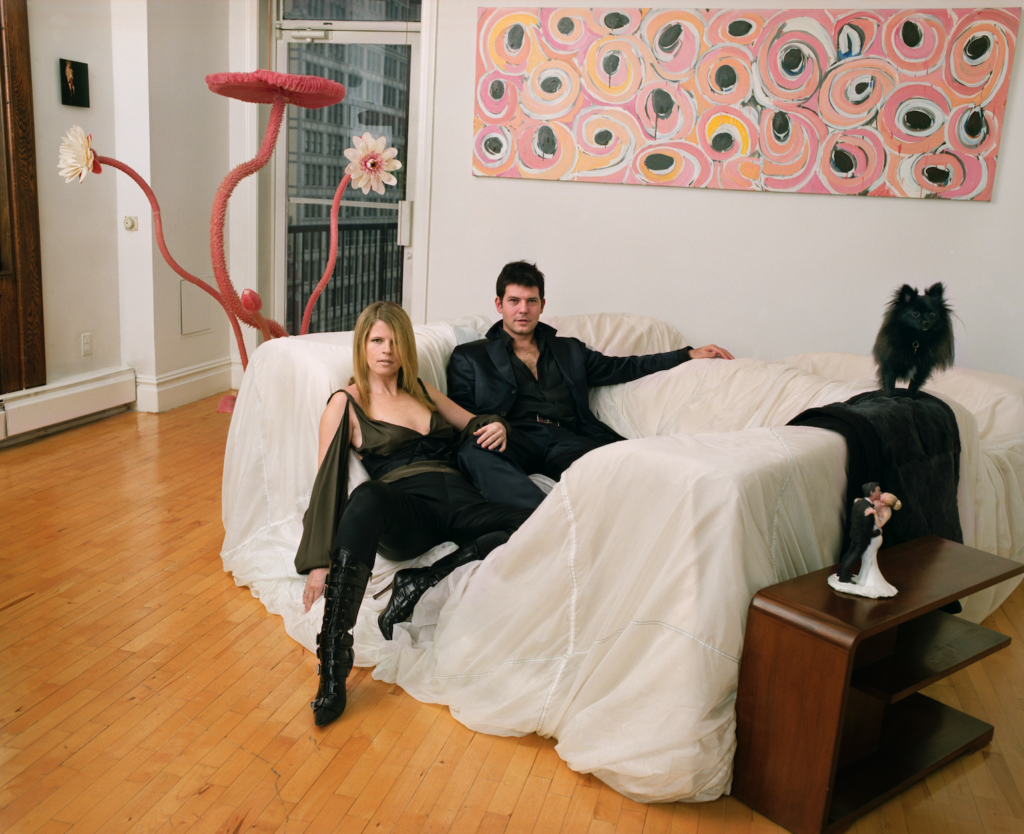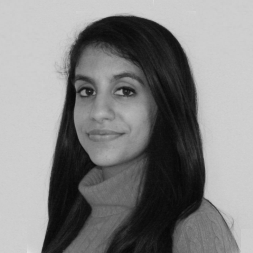Art maven Yvonne Force Villareal and artist Leo Villareal are a bona fide power couple—and that’s not just because of the megawatts of electricity that power Leo’s ambitious, city-sprawling illuminated artworks. Both are major figures in their own right: Yvonne is best-known for co-founding the New York-based nonprofit Art Production Fund and the creative consultancy Culture Corps, while Leo’s immersive light-based sculptures are represented by Pace Gallery. Given the scope of their art-related interests, it’s not so surprising to learn that the two fell in love over their shared passion—and that they have each played an instrumental role in the success of one another’s career.
Just before the opening of Villareal’s new solo show at Pace Gallery in London—timed to the recent launch of his newest public project, Illuminated River, which will light up all 14 bridges along the River Thames over the course of the next 10 years—the two sat down with Artnet News to discuss how they fell in love, the benefits of being a power couple, and how they discuss and engage with art as a family.
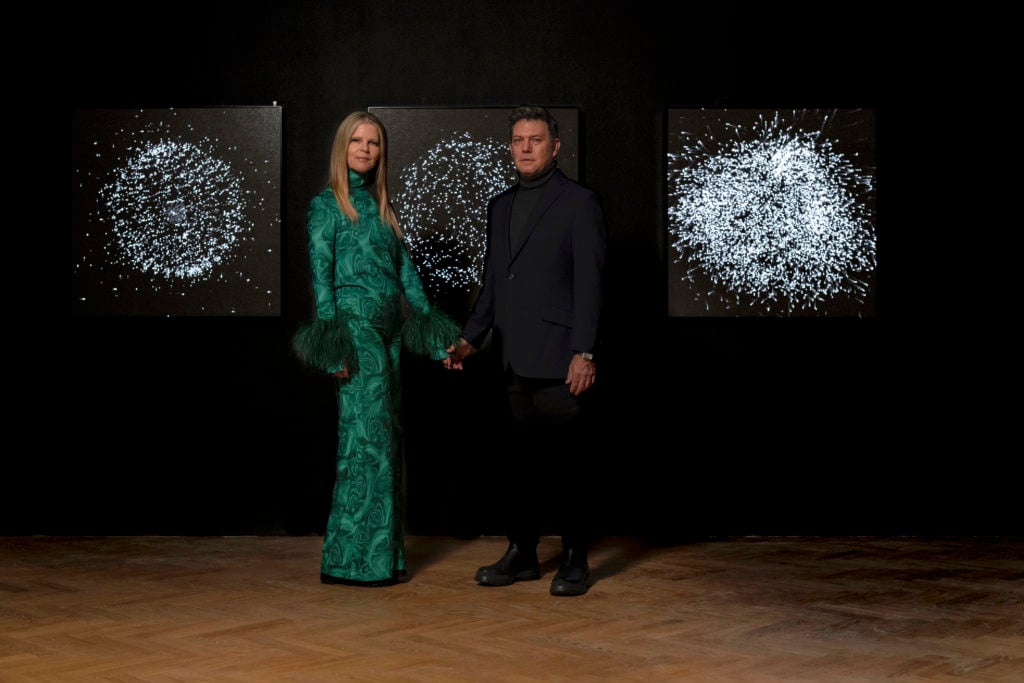
Yvonne Force Villareal and Leo Villareal at Pace Gallery in London. Photo by Damian Griffiths, courtesy Pace Gallery.
Tell me about how you both met, and how you fell in love.
Yvone Force Villareal: We actually just celebrated our 21st wedding anniversary.
Leo Villareal: We were married in ‘98. We probably met in ‘96. It was very much that kind of art-world romance. We met at A/D Gallery, at a show of John Chamberlain couches. Yvonne and I ended up buying the same one, mine covered in brown suede and hers a foam prototype.
Force Villareal: That was literally where we met for the first time. I worked at that gallery in the early ’90s and had fallen in love with the Chamberlain couches when I was there. At A/D, we commissioned artists to make functional objects, and then we showed them. It was a wonderful gallery. Leo and I ended up keeping the prototype couch. We still live with it and absolutely love it. Actually, we started falling in love while sitting on that couch that evening.
So you started talking about art right away. Did art play much of a role in your subsequent dates?
Force Villareal: Oh, yes. Our first real date, crazily enough, was the opening of Barbara Gladstone Gallery in Chelsea. It was a Gary Hill exhibition and then there was a dinner party afterwards, and Leo and I went. It was perfectly romantic for us to be in Chelsea at an art opening—Chelsea was the most exciting new frontier then. Our second date was at the [former] downtown Guggenheim for a Hugo Boss Prize exhibition that Matthew Barney had. So, from the very beginning, really everything was a conversation surrounding or about art.
What did you learn from each other while engaging with all that art together? Did you teach each other to see art in different ways?
Villareal: I had been living in San Francisco, and I’d been working at a research lab. Yvonne was at Yvonne Force Inc. [her art advisory] at the time. She was helping Laurance Rockefeller build an art collection, and was intimately connected to everything going on in New York. I definitely found that very attractive, and learned a tremendous amount about artists like Lisa Yuskavage and the other great artists that Yvonne was championing then. So it was really a wonderful experience for me. Around that time, I ended up moving back to New York, and we got engaged and married.
We’re both deeply connected to a lot of artists that we know, and a lot of art that we collect is very personal. Everything has a story, and there are connections to Yale, too. Matthew Barney was a year ahead of me, and Sarah Sze was a year behind me. I actually had another friend who ended up going to Barbara Gladstone Gallery, and a little while after we finished at Yale he said, “Why don’t you buy one of Matthew’s works?”
I hadn’t really thought about it, honestly. But it was really nice to be able to collect friends’ work, and when Yvonne and I met, we started collecting together. It’s been an amazing adventure. It’s also interesting to think about how accessible things were back then, and how that’s changed.
Force Villareal: At the time, Leo was living in Palo Alto and working in sculpture. He worked at Interval Research Corp’s laboratories doing works with virtual-reality technology. He was very involved in art-making that was interactive and sound-based, and then he made an incredible light installation.
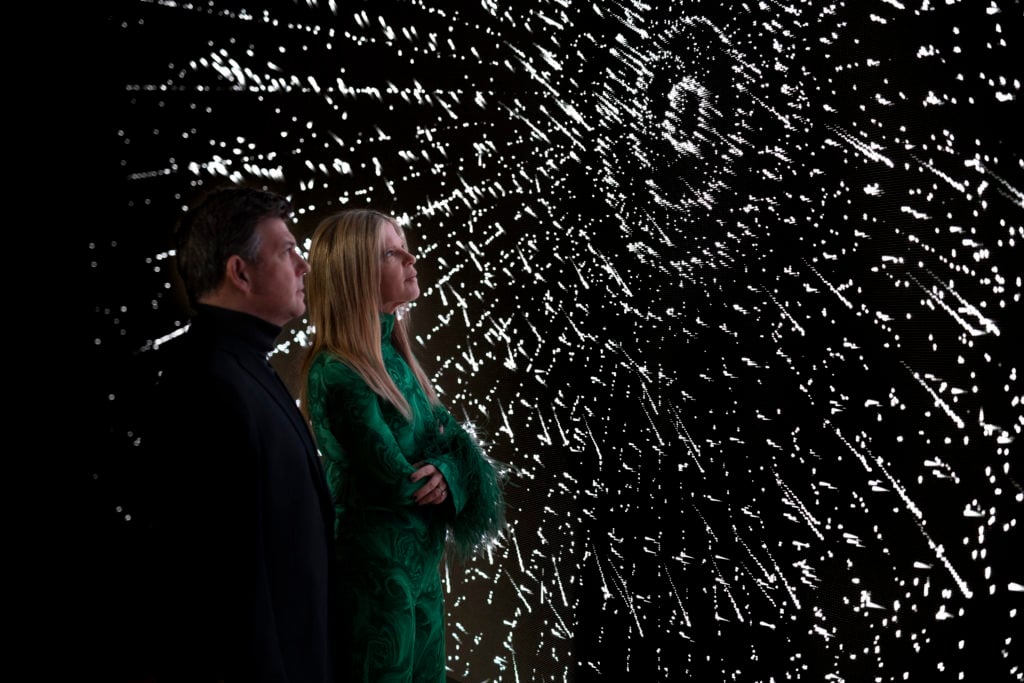
The Villareals at Pace Gallery in London. Photo by Damian Griffiths, courtesy Pace Gallery.
Villareal: That was in ‘97. I started going to Burning Man in 1994, and during my first experience, I kept getting profoundly lost because, while there were only a couple thousand people there at the time, it was very disorienting. By my third year, I’d created this beacon comprised of 16 strobe lights and a micro-controller. It was my way to get back home at night. It turned out that studying the combination of software, light, and space was really instrumental in getting me started in light-based sculpture.
So that was the beginning of that kind of work. I hadn’t even thought of the beacon as an artwork—it was just a utilitarian device—but I brought it back to my studio in Chelsea and was kind of amazed by the possibilities. It was digital object, but it had the impact of an artwork. To really engage in the aspects of full perception and opticality and all the things that you can do with light was really interesting to me. So that’s what I’ve been pursuing for the last 20 years.
Force Villareal: So, basically, he had this wonderful light piece in his studio then. It had great form, but it needed to be formalized. The first time we really worked together is when I suggested that maybe he frame it in some way. He started playing with Plexiglass and created a box for it, which really kind of made the lights fuse together. It became this very beautiful box of light. As a matter of fact, that was one of Leo’s first pieces to be acquired for a collection. The Horts [New York collectors Michael and Susan Hort] acquired that artwork, and hung it for many years, and might still have it in one of their hallways or atriums.
In 1998, I produced the first piece that I ever did under Yvonne Force Ink, with Vanessa Beecroft. I had been doing art advising, and I decided I really wanted to be creative, so I said to Vanessa, “Let me help you make your fantasy performance.” It ended up being at the Guggenheim on Fifth Avenue. It was called SHOW, and it was a phenomenal moment in the art world. It was on the cover of Artforum and 1,500 people came. It took about a year to plan, and I was with Leo then. The show was something I’d never done before and it was a very ambitious project, with this very young artist as the star, so his support meant everything. Right after that opened, we got engaged. It was then, also, that Doreen Remen—who I went to RISD with—and I co-founded Art Production Fund. We just realized there was a real opportunity to explore art in the public forum.
That’s another area where Leo and I have supported each other so much, in the making of Art Production Fund works like Prada Marfa and Ugo Rondinone’s Seven Magic Mountains. That’s work that you don’t get to leave at the office—it takes years to realize with your team and with your family and with your spouse. So supporting each other through these major projects is just something we would do. We were there for each other through the course of a tremendous growth period, and have accomplished so many projects within the public realm since that are really free and accessible to all audiences. That’s something that’s very important to both Leo and me.
What art do you collect together, and what art do you like living with?
Force Villareal: Every artwork we have has a story, and often it’s by a good friend of ours. We have a Rachel Feinstein mirror work that’s at the Jewish Museum right now and work by Lisa Yuskavage, John Currin, and Alex Katz. In 1992, Alex painted me, and I’ve been in over 20 of Alex’s paintings since, as cutouts. I think I’m his second-most-painted model after his wife, Ada. In each piece, I look really different. I’m also in a lot of Lisa Yuskavage’s work, though she’s only interested in me when I’m pregnant or postpartum.
But it’s such a great pleasure to be painted, and to be painted by Alex, who also did a wedding portrait of me and Leo, and another painting where we’re holding each other. We actually have the great honor of living with the latter. It has this peach-pink color in the background, which happens to be our favorite color, and when we saw it we said, “Oh my goodness. We need to own this work.” But back then it was out of our budget, so we did a payment plan and we eventually acquired the work. Alex was very generous with the price. It’s a painting that we love so much because it’s really the center of our home.
We also have, increasingly, more and more work by Leo. We’re working right now with a dear friend and interior designer, Fernando Santangelo, to create a much more immersive home environment where we can have huge wall works. We also work with Fernando on our home in Marfa, Texas—Leo’s great-great-grandfather was actually one of the founders of Marfa—so that’s another big project that we’re doing now. It’s a family home and it’s just been restored. Fernando took it from what he calls “granny” to “granny chic.” Leo’s in the process of building a studio out in the back acres, and that’s a place where we’re looking to do more work in the future. I’d do outdoor art commission or a residency program. That’s a project I’d probably do on my own down the line.
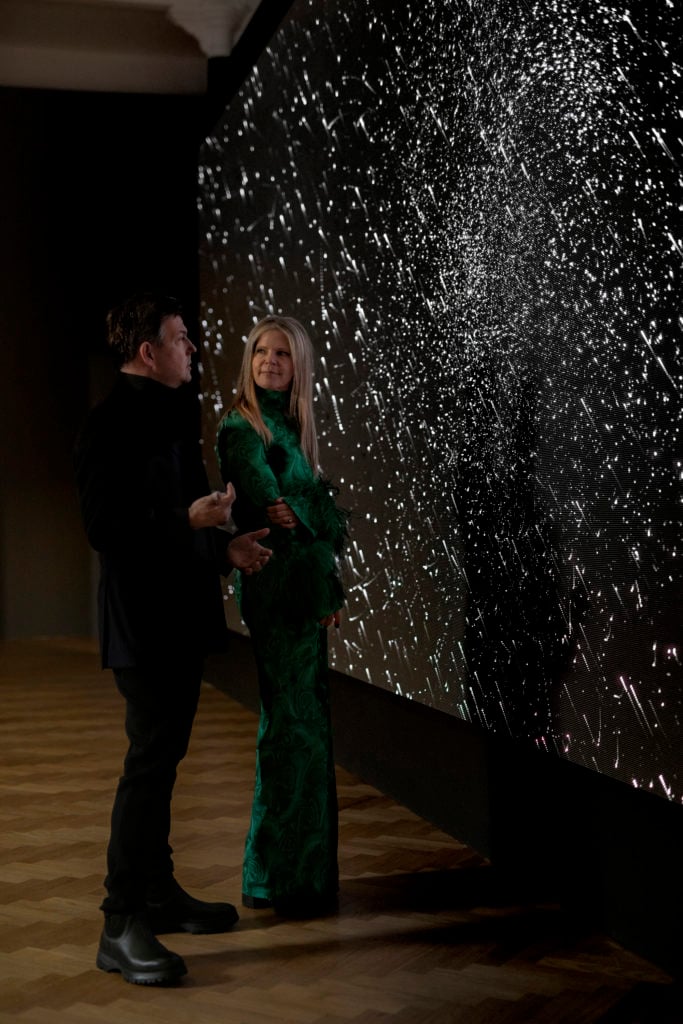
The Villareals at Pace Gallery in London. Photo by Damian Griffiths, courtesy Pace Gallery.
What’s one work you hope to one day acquire together?
Force Villareal: We continue to gain inspiration from the work of our time. We’d love to have more of our friends’ work, including pieces by Peter Halley, Loie Hollowell, and Hank Willis Thomas.
Leo, you just opened a show of new light works at Pace Gallery in London. What was your inspiration behind this latest exhibition and what are you hoping viewers take away from the work?
Villareal: The show uses LED-panels to create monochromatic works that display abstract patterns of undulating light. They could represent something either very large or very small. I hope viewers feel a sense of immersion, as if they’ve been taken on a journey by the work.
Readers are often curious about the daily lives of famous art-world figures. I’m sure your schedules vary wildly from day to day, but if you’re both in New York, are there any routines or rituals you like to maintain?
Villareal: We have two kids—Cuatro, who’s 16, and Lux, who’s nine. Before kids, it was much more about spending time at the studio and working longer hours and going out to events. Having kids has definitely been more grounding, and now it’s more about waking up and getting them to school and feeding them breakfast. Then I go off to the studio. My studio is in Sunset Park, Brooklyn. I’ve been there for five years, and before that I was in Chelsea for 15 years. I love being out in that industrial part of Brooklyn.
After my day at the studio, I’ll come back home and make dinner. I love cooking. I find it very relaxing. My favorite thing is to buy very fresh food at the farm stands in the North Fork, and share it with family and friends. I keep it simple. I grew up surrounded by great cooks in El Paso and Ciudad Juárez in Mexico. A lot of my cooking has a nostalgic quality to it, and I try to recreate what I ate when I was young. When we all get back home in the evening, it’s very nice to have these rituals of eating together while talking about our day, and then reading to Lux before she goes to sleep. All these things are really great, especially with all the travel we do. Sometimes the biggest luxury is just to stay home with the kids. We love supporting our friends with all of their openings and galas and things, but simultaneously, you have to take care of yourself, too, and be together as a family.
Force Villareal: After Doreen and I left the leadership positions at Art Production Fund, we started a new company together called Culture Corps. We have an office in the Cable Building in SoHo, but I also work part-time from home. I love being there when the kids get home from school. When I was running Art Production Fund with Doreen, I was out so much doing fundraising. When you’re running a nonprofit, you have to go out all the time. Culture Corps is great because I have different responsibilities now and most of my work happens during the day.
So, at night, we do have our cherished time with the kids. Our son is amazing. They’re both very artistic. Our daughter is at the JKO School at the American Ballet Theatre. Cuatro is young but he’s an environmental activist. He’s also a competitive sailor. So I wear the hat of sailing mom and ballet mom, and I love it. There’s not one thing I love more than taking my kids to their sailing regattas or ballet practice. And as Leo mentioned, a big part of our life is family meals. It’s really important to slow down and be present with the kids.
Do you take them to see art?
Force Villareal: We take them to see art, but only art that they’re going to be very engaged with. They’ll see a friend’s exhibition, like [photographer] Jessica Craig-Martin’s recent show. Or Sean Landers’s exhibition, or Hank Willis Thomas’s exhibition. Or we’ll show them something like the new Kusama show, because it’s a phenomenal show that I knew would speak to them directly. So I don’t drag them around to tons of galleries. I’m very specific with what they see. I want them to really love their art experiences.

The Villareals at Burning Man. Photo courtesy Eleanor Preger.
What is something that you feel you have taught each other, more generally?
Force Villareal: Leo and I were together for 11 years before I went to Burning Man. I don’t consider myself a judgmental person, but I didn’t want anything to do with Burning Man. I didn’t think I was going to like the art, and I grew up in a trailer in Key West and the last thing I wanted to do was go stay in an RV at the end of the summer in the desert. Nothing about that interested me. Leo never asked me to reconsider, though. Then, one year, I finally decided that I was going to go. The moment I got there, I knew I’d been wrong about it.
So we support each other, but we’re also very independent. We have a lot of combined interests, but we also allow each other to have our space. I’ll go to some fashion events, for example, and he is not interested in that at all. He was going to Burning Man alone for years, and I was totally fine with him going for two or three weeks at a time. People would say, “How can you let your husband do that?” And I said, “Because I trust him 100 percent.” But when I did go, I started looking at art differently. I actually really responded to a lot of it, even though it looked so different from art as I knew it.
I realized what’s important is the incredible creative community that’s there, and that’s led me to understand that there are multiple art worlds and multiple ways of being creative. Leo’s taught me to support all forms of creativity, and realize how precious it is. There’s so little of it in the world. I would say, above all, an enhanced appreciation for all levels of creativity is something that Leo has taught me. What have I taught you, Leo? [laughs]
Villareal: I think Yvonne is incredibly wise when it comes to navigating the art world and the social aspects of it, and I think she does it with tremendous grace and diplomacy. That’s been very useful to me as an artist. Also, around the time Yvonne started coming to Burning Man, she introduced me to yoga, which is wonderful. I think it’s really important to grow together and to find new things to do, and be open to the next phases of our lives. I think we’re both incredibly excited about what’s coming next.
Since you mentioned Burning Man, I’ve always wondered: How do you plan your great outfits? Yvonne, your sense of style is also quite renowned in the art and fashion worlds alike. Tell me what you love most about fashion.
In many ways, clothes help to shape my mood and augment aspects of my personality in the ways I need them to, depending on the day. For example, I have art-fair looks, which are more serious but stylish, and I love a good black-tie dress code, which is always a nice occasion to rise to. I have a separate wardrobe for my sailing-mom persona—the only closet that allows anything with navy blue and stripes. I could go on and on. We 21st-century women are complex creatures, and clothes can be an effective tool to showcase that!
A few years ago, I also decided to only wear clothes designed by either my friends or the supporters of our art projects. I am beyond grateful to don looks by Bonnie Young, Stacey Bendet Eisner of Alice & Olivia, Lisa Perry, Cynthia Rowely, Tom Ford, Prada, and Gucci. Those are my people.
For Burning Man, in the Black Rock Desert, I become my fantasy version of myself. I’ve collaborated with some of my designer friends to make unique outfits, which has turned me on to creating my very own designs or putting unique spins on pieces that cannot be acquired anywhere else. It’s great fun.
